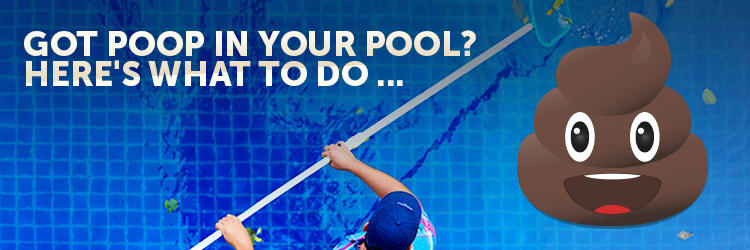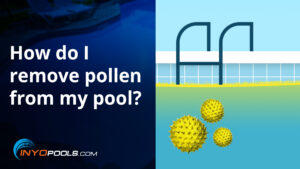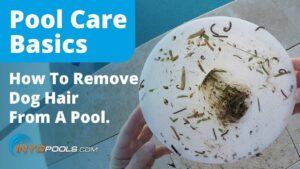This is a nightmare scenario for any pool owner. Someone’s chicken nuggets don’t agree with him/her and before know it, you have Code Brown on your hands. And if it is your pool, it comes down to you to clean it up. Because fecal matter in a pool poses a health risk due to exposure to bacteria and parasites, you need to operate with a clear mind in such murky times. In this article, we’ll show you exactly how to rid your pool of the brown menace, both solid and not so solid.
But generally what is the best action when you have fecal matter in the pool?
Quick answer: Shock the crap out of it.
Well, yes. Shocking the water is the best way to sterilize your water, short of draining the pool entirely. Another important factor is time. The pool must be kept at shock levels for certain periods of time depending on the type of fecal matter in the pool.
Why Is a Poopy Pool Bad?
Besides the obvious fact that no one wants to swim in a toilet, Accidental Fecal Releases (AFRs) introduce a wide range of germs to your pool. The most well-known and dangerous to swimmers are Giardia and Cryptosporidium parasites.
Giardia
Giardia is a parasite that causes extreme diarrhea, cramping, bloating and fatigue. Sufferers would compare a Giardia infection as similar to food poisoning, except it can last for six to eight weeks.
Some people who carry this parasite may never present signs of the infection, but still pose a risk to infect others via contact with their stool.
Cryptosporidium (Crypto)
Cryptosporidium also presents symptoms similar to Giardia, but add in a severe cough and fever. Symptoms of Crypto can last one to two weeks, but can last longer in serious cases.
Both of these parasites are bad news. So, here are the ways to purge your pool of all these nasties without draining your water.
How to Clean Solid Fecal Matter From Your Pool
Not that I would ever wish poop to be in your pool, but if it were to be in there you would want the solid kind. Due to its makeup, this material clumps together, lessening the infection zone. For the most part you can remove it from your pool and then run through a normal shock cycle.
Step 1: Close your pool immediately. To lessen the chance of infection, get all swimmers out of the pool and remove all the toys and floats.
Step 2: Remove as much of the fecal matter as possible. The preferred method is a net and bucket. DO NOT VACUUM THE FECAL MATTER.
Step 3: Shock your pool with sodium hypochlorite. Raise your free chlorine (FC) level by at least 2 parts per million. Hold your chlorine level at this shock level for 25-30 minutes. If your shock level varies from the 2 ppm recommended dose, review the chart.
How to Clean Diarrhea in Your Pool
The process of cleaning diarrhea is more intense because of the fluid nature of the material. Because it is liquid, the stool will begin to mix with the pool water immediately, widening the infected area. The cleaning process goes from minutes for solid material to hours for diarrhea. The shock needs to have time to seek out all nasty things in your water, and then destroy them.
Step 1: Close the pool immediately. Remove swimmers from the pool and have them wash as soon as possible.
Step 2: Remove as much of the solid portions of the stool as possible. VACCUMING THE FECAL MATTER IS NOT RECOMMENDED.
Step 3: To make sure your shock is working at full efficiency, you need your pool’s cyanuric acid (CYA), also known as stabilizer, to be between 1-15 ppm. Test your water. For CYA levels above our necessary dose, drain your pool of the percentage between your pool’s CYA levels and 15 ppm. Then refill with fresh water.
For example: If your pool’s CYA level is 50 ppm, the equation would go as so.
50 ➗ 15 = .3 or 30%
You would need to drain 70% of your pool water.
Anything more than that 70 percent, you’ll probably just want to drain the pool completely and start from scratch. Test your pool water’s cyanuric acid level.
Step 4: Hyperchlorinate your pool by adding pool shock and maintain this shock level for an extended period of time. Using sodium hypochlorite (pool shock) you will need to hyperchlorinate your pool for an extended period of time to ensure your pool is free of harmful parasites and bacteria. Follow the chart provided by the CDC.
Step 5: Backwash the filter thoroughly and replace filter media if necessary, e.g. filter cartridges, sand, DE powder and grids. Sometimes even the hyperchlorination can’t get your filter media clean, so it is best to start anew to prevent a flare up of bacteria down the line.
Well, that just about covers it. If you have any ideas about how to clean your pool, or possibly even a story, leave a comment down below.















Leave a Reply